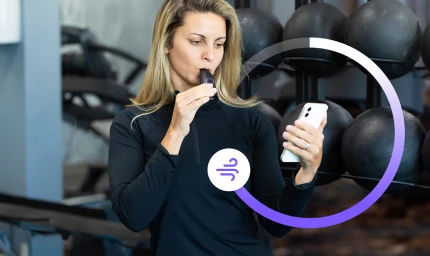Why you should measure your metabolism


We often measure things like body weight, cholesterol, and blood sugar levels to get an accurate picture of our health. While considered the most accessible metrics, they’re far from the most informational and don’t tell the whole story of our health, especially with weight management. Did you know it’s also possible—and beneficial—to measure your metabolism?
Metabolism encompasses all the vital processes handled by your mitochondria, the powerhouses of your cells that convert carbs and fats into energy to keep you alive.
Your metabolism provides energy for the body to breathe, digest food, regulate hormones, repair cells, and fulfill many other functions.
Measuring metabolism isn’t a novel concept — it’s been helping world-class athletes reach peak fitness levels for years. Measuring metabolic health through the breath can be done by tracking the respiratory exchange ratio (RER), which is the ratio between the carbon dioxide (CO2) produced by the body and the amount of oxygen (O2) consumed. This helps identify whether the mitochondria – our metabolic powerhouses – are burning carbs or fats as fuel. Healthy mitochondria should burn fat at rest, while fasting, or during prolonged low-intensity activity, and carbs during high-intensity activity, after meals, and when short bursts of energy are needed.
When it first came to the scene, measuring RER required a person to be placed in a metabolic cart or chamber for up to 60 minutes and a trained practitioner to analyze the results. Fast forward to today, Lumen has reduced the time it takes to measure metabolic fuel usage from 60 minutes to a single breath. It measures the CO2 concentration in your breath to determine metabolic fuel usage and provides the same accuracy as the metabolic cart in the form of a handheld device. By taking metabolic measurements out of the clinical setting and allowing for multiple measurements within the context of people’s lives (e.g., in the morning, before workouts, after meals, and more), it shines a light into metabolic health that didn’t previously exist. Before this innovation, only about 1 million metabolic measurements had ever been recorded. Now, there are over 60 million.
When you measure your metabolism – whether you’re burning carbs, fats, or both – you can unlock so much information you might not have thought about. It can help you understand your body and get to the root cause of many symptoms, such as low energy, weight gain, chronic fatigue, muscle loss, and metabolic syndrome.
Measuring your metabolism also helps you gauge your level of metabolic flexibility, which is your mitochondria’s ability to easily switch between carb and fat burn [1]. Improved metabolic flexibility can lead to better sleep, higher energy levels, and stable glucose levels.
Metabolic flexibility is dynamic and can change frequently. Lifestyle factors such as dietary choices, physical activity, sleep quality, and stress levels all play a role in your metabolic health. By measuring your metabolism, you’ll get a good idea of how you’re doing in real-time, and it’ll paint a bigger picture of how your daily choices affect your metabolic health over time.
For example, if you wake up in carb burn one morning, it could be isolated to eating a carb-heavy meal the night before. However, continuously waking up in carb burn may point to something more profound and chronic regarding your metabolic health.
This direct biofeedback loop can help you stick with your current routine or make immediate adjustments to improve your mitochondrial state in the short term and metabolic health in the long term.
Now that you understand the importance of metabolic flexibility, let’s dive deeper into the benefits of using metabolic trackers to measure your metabolism.
Knowing whether your mitochondria are burning fats or carbs when you wake up reveals a lot about your metabolic health. In the short term, it points to how your mitochondria are handling your lifestyle choices from the night before or the past few days. In the long term, with consistent measurements, it can reveal patterns that indicate overall metabolic health.
Waking up in fat burn is the goal since you should be at rest and in a fasted state while sleeping. It’s a sign of balance between the four major areas of your lifestyle: nutrition, movement, sleep, and stress management.
That balance can be delicate when you look at the short term. For example, if you eat a carb-rich meal or drink too much wine one night and wake up in carb burn, it doesn’t mean you are metabolically unhealthy. You can adjust your lifestyle choices the following day to train your mitochondria to be resilient and metabolically flexible. However, if you constantly wake up in carb burn for weeks, it can be an early indicator of metabolic syndrome. Take it as a sign to look into your daily routines and gradually make habit changes to shift your mitochondria into morning fat burn.
According to Dr. Mark Hyman, “Understanding your unique metabolism and making effective changes is the future of personalized medicine. Monitoring your metabolic health regularly and implementing any necessary lifestyle changes can help you catch any issues before they escalate.”
Measuring your metabolism before and after a carb-rich meal to see if your body shifts to burning carbs is also important. People with a healthy BMI and better metabolic flexibility demonstrate a greater post-meal carb response, burning more of the carbs they eat for energy, rather than storing them as fat [2].
If carbohydrates aren’t used as energy, glucose stays in the bloodstream longer, causing insulin resistance over time. When blood glucose levels remain chronically high because of insulin resistance, the body flags it as harmful and stores excess glucose as fat.
Overconsuming carbohydrates also causes glycogen, the body’s carb stores, to be overfilled. As a result, glycogen stores don’t empty enough to allow for fat burn or to trigger mitochondrial biogenesis. This not only affects mitochondrial health, it also means you have fewer mitochondria.
To this end, measuring your metabolism can be an early warning system for potential metabolic health issues. Conditions like hypothyroidism, insulin resistance, or metabolic syndrome can often go unnoticed until they manifest as more serious health problems [3].
If you notice these patterns when taking metabolic measurements, there are several ways you can shift your lifestyle to restore balance. For example, consider the quality and timing of your carbs.
Opt for complex carbs like brown rice and quinoa and eat them with healthy fats and protein to prevent blood sugar spikes.
You can also time your carbohydrate intake earlier in the day or around high-intensity exercise and weightlifting so your muscles use carbs for fuel.
You may think you’re getting quality sleep, but your metabolism can tell you much more. This holds true if your lifestyle seems to be in check, yet you constantly wake up tired.
When you wake up in carb burn, you may have eaten too late, didn’t sleep well, are experiencing hormonal shifts, or are getting ill.
If you constantly wake up in carb burn, it’s a sign to rethink and adjust some of your lifestyle choices to be more metabolically flexible. This will also help with weight loss, better sleep, and more energy throughout the day.
For example, you could plan to eat most of your carbs earlier in the day to give your body enough time to use them for energy. To ensure restful sleep, avoid blue light and bright screens right before bed and opt for red light therapy. Research shows that red light therapy can increase the number of mitochondria [4] and boost mitochondrial function by exciting electrons with photons from red and near-infrared light [5].
This process enhances ATP production, powering your cells and giving you more energy.
Mia Johanna Dige, a metabolic coach at Lumen, shares, “A metabolically flexible person wakes up more often burning fat and shifts easily to burning carbs after eating without storing it as body fat.”
If you’ve ever dragged your feet through a workout and felt depleted of energy for the entire session, it might be a sign that you didn’t properly fuel your body before. By measuring your metabolism before a high-intensity workout like weightlifting or sprinting, you’ll know whether you’re burning carbs or fats for energy.
If you’re burning carbs, that indicates you don’t need to eat more carbs before hitting the gym. If your mitochondria are burning fats, you should eat some fast-digesting carbs beforehand, like a banana, to have enough energy to power through your session.
Not only is proper fuel important for athletic performance and endurance, it also ensures your body doesn’t burn through your hard-earned muscle mass because it lacks enough carbs to support the bursts of energy needed for resistance training.
Maintaining your muscle mass is important because the more muscle you gain, the more mitochondria and glycogen you’ll have. This translates to more energy, more effective fat metabolism, and increased glycogen storage, ensuring less glucose will be stored as fat when consuming carbs.
During periods of low glucose availability, as with fasting, your mitochondria help your body make the switch to alternative fuel sources like fatty acids and ketones, increasing your endurance and energy [6].
Intermittent fasting has become quite popular among people trying to improve their health and lose weight. However, finding an ideal fasting window – especially for women with their fluctuating hormone levels – is not as clear without the help of a metabolism tracker.
When you fast just long enough, your mitochondria burn fat for energy. However, if you extend your fasting window too long and start burning carbs again, that’s a sign of muscle breakdown and indicates that you should break your fast.
Each person’s ideal fasting window will vary, and knowing what works best for you by measuring your metabolism is key for effective fasting.
Measuring your metabolism reveals hidden connections between your lifestyle and metabolic health. It can help you set realistic and sustainable health and fitness goals that will last. Improvements in your metabolic rate over time can motivate you to stay on track and progress towards your goals.
Poor metabolic health influences your risk of chronic diseases, such as type 2 diabetes and cardiovascular disease. Luckily, metabolic measurement is becoming increasingly accessible, making it easier than ever to stay on top of your metabolism.
When it comes to metabolic health, what works for one person may not necessarily work for another. Metabolism trackers allow you to determine what fuel your body is using in real-time. This personalized biofeedback helps you tailor your diet, exercise regimen, and lifestyle choices to better support your metabolic health.
Whether your goal is to boost energy levels, improve insulin sensitivity, or enhance your overall health, better understanding your metabolism can lay the foundations for long-term success.
[1] Goodpaster, B. H., & Sparks, L. M. (2017). Metabolic flexibility in health and disease. Cell Metabolism, 25(5), 1027–1036. https://doi.org/10.1016/j.cmet.2017.04.015
[2] Yeshurun, S., Cramer, T., Souroujon, D., & Mor, M. (2024a). The Association of Macronutrient consumption and BMI to exhaled carbon dioxide in lumen users: Retrospective real-world study. JMIR mHealth and uHealth, 12. https://doi.org/10.2196/56083
[3] Palmer, B. F., & Clegg, D. J. (2022a). Metabolic flexibility and its impact on health outcomes. Mayo Clinic Proceedings, 97(4), 761–776. https://doi.org/10.1016/j.mayocp.2022.01.012
[4] Karu, T. (1999a). Primary and secondary mechanisms of action of visible to near-IR radiation on cells. Journal of Photochemistry and Photobiology B: Biology, 49(1), 1–17. https://doi.org/10.1016/s1011-1344(98)00219-x
[5] Ferraresi, C., Kaippert, B., Avci, P., Huang, Y., de Sousa, M. V., Bagnato, V. S., Parizotto, N. A., & Hamblin, M. R. (2014a). Low‐level laser (light) therapy increases mitochondrial membrane potential and atp synthesis in C2C12 Myotubes with a peak response at 3–6 h. Photochemistry and Photobiology, 91(2), 411–416. https://doi.org/10.1111/php.12397
[6] Spinelli, J. B., & Haigis, M. C. (2018). The multifaceted contributions of mitochondria to cellular metabolism. Nature Cell Biology, 20(7), 745–754. https://doi.org/10.1038/s41556-018-0124-1

Our Lumen editorial desk includes an in-house team of certified and registered nutritionists and dietitians, scientists, researchers, and writers.